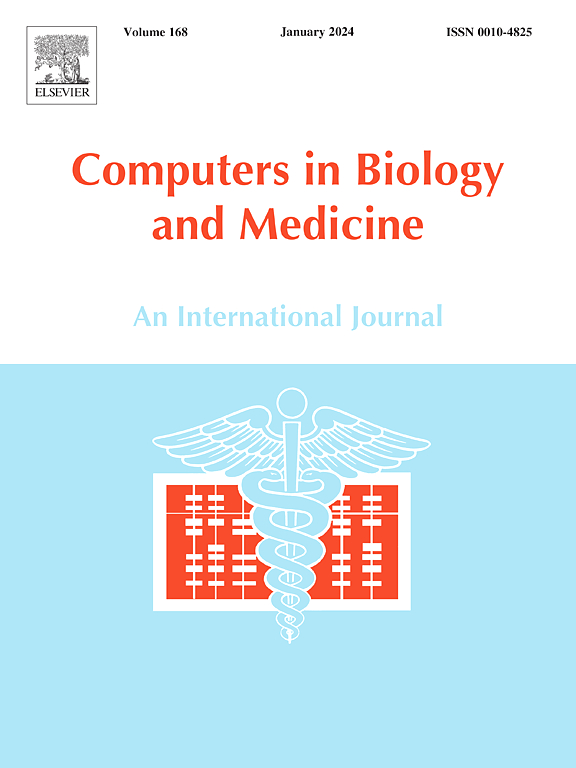利用脑电图信号增强深度学习网络的公共空间模式以改进酒精中毒检测
IF 7
2区 医学
Q1 BIOLOGY
引用次数: 0
摘要
许多健康问题的主要风险因素之一是过度饮酒。酗酒是一种严重的疾病,会影响一个人的思维和认知能力。早期发现酒精中毒可以帮助受试者重新控制他们的饮酒习惯,帮助他们更快地恢复。酒精中毒的诊断是具有挑战性的,主要是当标准诊断测试依赖于血液测试和问卷调查时,这对病人和考官来说都是主观的。这就需要一种快速、可靠、自动且最好是非侵入性的方法来检测酒精中毒。脑电图(EEG)是一种捕捉大脑电活动的非侵入性方法。它可以帮助检测受试者的酒精使用障碍。据我们所知,以前的文献中没有研究提出一种利用脑电图信号检测酒精中毒的机制,该机制使用深度学习模型来考虑脑电图信号的时空性质。文献中使用深度学习架构的两个作品是Fayyaz等人(2019)和Farsi等人(2021)。然而,两者都使用了简单的深度学习架构,忽略了多通道脑电信号的时空性质。本文提出了一种新的混合架构CSP-CNN-LSTM-ATTN。从脑电信号中获得非线性和非平稳的时空特征,可以准确地将其分类为酒精或控制(非酒精)。我们的方法集成了通用空间模式(CSP)用于特征提取,卷积神经网络(CNN)用于空间表示,长短期记忆(LSTM)用于时间学习,注意网络(ATTN)用于特征加权,提高了分类性能。在公开可用的UCI EEG数据集上的实验表明,我们的模型取得了最先进的结果,优于现有的方法,准确率为98.60%,f1得分为98.59,召回率为98.24,精度为98.95,MCC为97.20,AUC为99.64。本研究的源代码可在Github存储库https://github.com/n28neeraj/Alcoholism-Detectio获得。本文章由计算机程序翻译,如有差异,请以英文原文为准。
Augmenting Common Spatial Patterns to deep learning networks for improved alcoholism detection using EEG signals
One of the main risk factors for numerous health problems is excessive drinking. Alcoholism is a severe disorder that can affect a person’s thinking and cognitive abilities. Early detection of alcoholism can help the subject regain control over their drinking habits and help them recover faster. The diagnosis of alcoholism is challenging, primarily when standard diagnostic tests rely on blood tests and questionnaires that are subjective to the patient and the examiner. This poses the need for fast, reliable, automatic, and preferably non-invasive ways to detect alcoholism. A non-invasive method to capture the electrical activity of the brain is the electroencephalogram (EEG). It can help detect alcohol use disorders in a subject. To our knowledge, no previous work in the literature proposes a mechanism to detect alcoholism using an EEG signal using a deep learning model that considers the spatio-temporal nature of EEG signals. Two works in the literature using a deep learning architecture are Fayyaz et al. (2019) and Farsi et al. (2021). However, both use a simple deep learning architecture and ignore the spatio-temporal nature of multichannel EEG signals. This paper suggests a new hybrid architecture called CSP-CNN-LSTM-ATTN. To obtain nonlinear and nonstationary spatio-temporal features from EEG signals that can accurately classify them as either alcoholic or control (not alcoholic). Our method integrates Common spatial patterns (CSP) for feature extraction, convolutional neural networks (CNN) for spatial representation, long-short-term memory (LSTM) for temporal learning, and attention networks (ATTN) for feature weighting, enhancing classification performance. Experiments on the publicly available UCI EEG dataset demonstrate that our model achieves state-of-the-art results, outperforming existing methods with an accuracy of 98.60%, F1-score 98.59, recall 98.24, precision 98.95, MCC 97.20, and AUC 99.64. The source code for this study is available at Github repository https://github.com/n28neeraj/Alcoholism-Detectio.
求助全文
通过发布文献求助,成功后即可免费获取论文全文。
去求助
来源期刊

Computers in biology and medicine
工程技术-工程:生物医学
CiteScore
11.70
自引率
10.40%
发文量
1086
审稿时长
74 days
期刊介绍:
Computers in Biology and Medicine is an international forum for sharing groundbreaking advancements in the use of computers in bioscience and medicine. This journal serves as a medium for communicating essential research, instruction, ideas, and information regarding the rapidly evolving field of computer applications in these domains. By encouraging the exchange of knowledge, we aim to facilitate progress and innovation in the utilization of computers in biology and medicine.
 求助内容:
求助内容: 应助结果提醒方式:
应助结果提醒方式:


